Research on Thermal Dissipation Characteristics Based on the Physical Laws of Forced Vibration in Granular Assemblies
Abstract
:1. Introduction
2. Analysis of the Vibration Energy Characteristics of Particles
3. Mathematical and Physical Model of Thermal Energy Dissipation in Particle Assembly
4. Granular Assembly Frequency Variation Thermal Loss Testing Device
5. Analysis of Thermal Loss Results for Granular Assemblies
5.1. Analysis of Thermal Uplift Characteristics of Granular Assemblies under Typical Vibration Conditions
5.2. Analysis of Frequency-Varying Heating Characteristics of Granular Assemblies
5.3. Analysis of Frequency-Varying Heat Loss Characteristics of Particles
6. Conclusions and Prospects
Author Contributions
Funding
Institutional Review Board Statement
Informed Consent Statement
Data Availability Statement
Conflicts of Interest
Appendix A. Discrete Element Vibration Energy Characteristics Model
| Parameters | Values |
|---|---|
| Density of granular material, | 7800 |
| Elastic modulus of granular materials, | |
| Poisson’s ratio of the granular materials, | 0.3 |
| Particle size, | 2 |
| Material density of the granular container, | 1190 |
| Elastic modulus of granular container material, | |
| Poisson’s ratio of granular container material, | 0.37 |
| Restitution coefficient, | 0.92 |
| Static friction coefficient, | 0.3 |
| Rolling friction coefficient, | 0.01 |
| Time step, | |
| Gravity acceleration, | 9.79 |
Appendix B. Granular Vibration Transition Curves and Vibration State
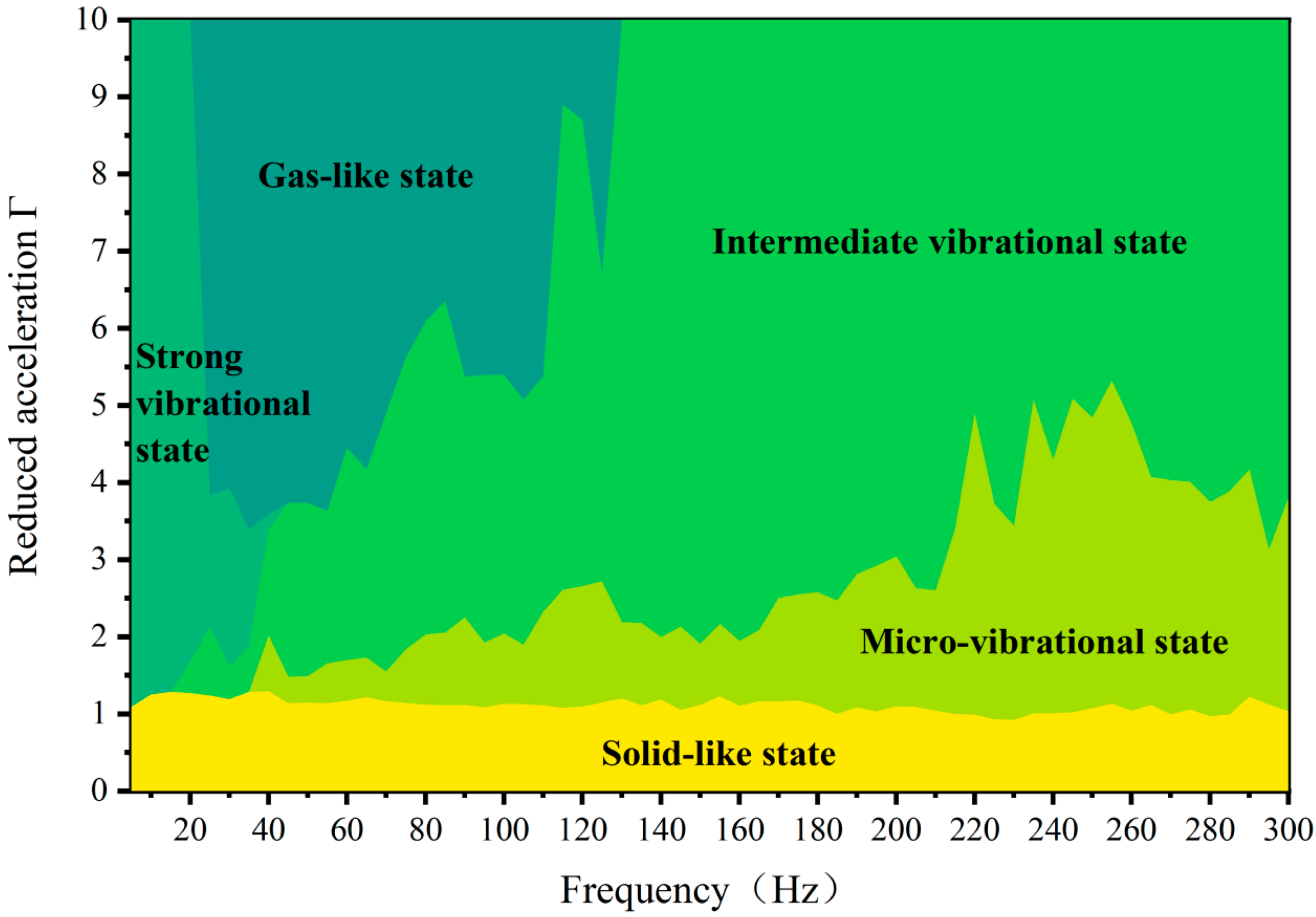

References
- Gagnon, L.; Morandini, M.; Ghiringhelli, G.L. A review of particle damping modeling and testing. J. Sound Vib. 2019, 459, 114865. [Google Scholar] [CrossRef]
- Lu, Z.; Masri, S.F.; Lu, X.; Lu, Z.; Masri, S.F.; Lu, X. Origination, development and applications of particle damping technology. In Particle Damping Technology Based Structural Control; Springer: Singapore, 2020; pp. 21–51. [Google Scholar]
- Lu, Z.; Wang, Z.; Masri, S.F.; Lu, X. Particle impact dampers: Past, present, and future. Struct. Control Health Monit. 2018, 25, e2058. [Google Scholar] [CrossRef]
- de Gennes, P.G. Granular matter: A tentative view. Rev. Mod. Phys. 1999, 71, S374. [Google Scholar] [CrossRef]
- Wong, C.X.; Daniel, M.C.; Rongong, J.A. Energy dissipation prediction of particle dampers. J. Sound Vib. 2009, 319, 91–118. [Google Scholar] [CrossRef]
- Meyer, N.; Seifried, R. Toward a design methodology for particle dampers by analyzing their energy dissipation. Comput. Part. Mech. 2021, 8, 681–699. [Google Scholar] [CrossRef]
- Friend, R.D.; Kinra, V.K. Particle Impact Damping. J. Sound Vib. 2000, 233, 93–118. [Google Scholar] [CrossRef]
- Meyer, N.; Seifried, R. Energy dissipation in horizontally driven particle dampers of low acceleration intensities. Nonlinear Dyn. 2022, 108, 3009–3024. [Google Scholar] [CrossRef]
- Mao, K.; Wang, M.Y.; Xu, Z.; Chen, T. DEM simulation of particle damping. Powder Technol. 2004, 142, 154–165. [Google Scholar] [CrossRef]
- Chen, T.; Mao, K.; Huang, X.; Wang, M.Y. Dissipation mechanisms of nonobstructive particle damping using discrete element method. In Proceedings of the SPIE’s 8th Annual International Symposium on Smart Structures and Materials, Newport Beach, CA, USA, 2 July 2001; Volume 4331, pp. 294–301. [Google Scholar]
- Yin, Z.; Su, F.; Zhang, H. Investigation of the energy dissipation of different rheology behaviors in a non-obstructive particle damper. Powder Technol. 2017, 321, 270–275. [Google Scholar] [CrossRef]
- Zhang, K.; Zhong, H.; Chen, T.; Kou, F.; Chen, Y.; Bai, C. Dissipation behaviors of granular balls in a shaken closed container. Mech. Syst. Signal Process. 2022, 172, 108986. [Google Scholar] [CrossRef]
- Zhang, K.; Zhong, H.; Kou, F.; Chen, Y.; Gao, Y. Dissipation behaviors of suspended granular balls in a vibrated closed container. Powder Technol. 2022, 399, 117158. [Google Scholar] [CrossRef]
- Fowler, B.L.; Flint, E.M.; Olson, S.E. Effectiveness and Predictability of Particle Damping. In Proceedings of the SPIE’s 7th Annual International Symposium on Smart Structures and Materials, Newport Beach, CA, USA, 27 April 2000; pp. 356–367. [Google Scholar] [CrossRef]
- Xu, Z.; Wang, M.Y.; Chen, T. Particle damping for passive vibration suppression: Numerical modelling and experimental investigation. J. Sound Vib. 2005, 279, 1097–1120. [Google Scholar] [CrossRef]
- Simonian, S.S. Particle beam damper. In Proceedings of the Smart Structures and Materials ‘95, San Diego, CA, USA, 5 May 1995; p. 2445. [Google Scholar]
- Esipov, S.E.; Poschel, T. Dissipative properties of granular ensembles. In Proceedings of the 5th Annual International Symposium on Smart Structures and Materials, San Diego, CA, USA, 16 June 1998; Volume 3327, pp. 19–26. [Google Scholar]
- Hunt, A.J. Small Particle Heat Exchangers; Lawrence Berkeley Lab, California University: Berkeley, CA, USA, 1978. [Google Scholar]
- Tsotsas, E. Particle-particle heat transfer in thermal DEM: Three competing models and a new equation. Int. J. Heat Mass Transf. 2019, 132, 939–943. [Google Scholar] [CrossRef]
- Haydar, C.; Martin, S.; Bonnefoy, O. Long time extrapolation of DEM with heat conduction in a moving granular medium. Chem. Eng. Sci. 2023, 277, 118815. [Google Scholar] [CrossRef]
- Chaudhuri, B.; Muzzio, F.J.; Tomassone, M.S. Experimentally validated computations of heat transfer in granular materials in rotary calciners. Powder Technol. 2010, 198, 6–15. [Google Scholar] [CrossRef]
- Thomas, B.; Mason, M.; Sprung, R.; Liu, Y.; Squires, A. Heat transfer in shallow vibrated beds. Powder Technol. 1998, 99, 293–301. [Google Scholar] [CrossRef]
- Tada, É.F.R.; Bück, A.; Casciatori, F.P.; Tsotsas, E.; Thoméo, J.C. Investigation of heat transfer in partially filled horizontal drums. Chem. Eng. J. 2017, 316, 988–1003. [Google Scholar] [CrossRef]
- Cheng, G.J.; Yu, A.B.; Zulli, P. Evaluation of effective thermal conductivity from the structure of a packed bed. Chem. Eng. Sci. 1999, 54, 4199–4209. [Google Scholar] [CrossRef]
- Sullivan, W.N.; Sabersky, R.H. Heat transfer to flowing granular media. Int. J. Heat Mass Transf. 1975, 18, 97–107. [Google Scholar] [CrossRef]
- Holman, J.P. Heat Transfer; McGraw Hill: New York, NY, USA, 1986. [Google Scholar]
- Razgaitis, R.; Holman, J.P. A survey of heat transfer in confined swirl flows. Future Energy Prod. Syst. Heat Mass Transf. Process. 1976, 2, 831–866. [Google Scholar]
- Oda, M.; Iwashita, K.; Kakiuchi, T. Importance of particle rotation in the mechanics of granular materials. Powders Grains 1997, 97, 207–210. [Google Scholar]
- Chlebnikovas, A.; Jasevičius, R. Investigation of the interaction of particulate matter and its separation from the gas flow in a multi-channel cyclone with recirculation. Granul. Matter 2022, 24, 98. [Google Scholar] [CrossRef]
- Tsuji, Y.; Tanaka, T.; Ishida, T. Lagrangian numerical simulation of plug flow of cohesionless particles in a horizontal pipe. Powder Technol. 1992, 71, 239–250. [Google Scholar] [CrossRef]
- Mueth, D.M.; Debregeas, G.F.; Karczmar, G.S.; Eng, P.J.; Nagel, S.R.; Jaeger, H.M. Signatures of granular microstructure in dense shear flow. Nature 2000, 406, 385–389. [Google Scholar] [CrossRef] [PubMed]
- Hopkins, M.A.; Shen, H.H. A Monte-Carlo Solution for Rapidly Shearing Granular Flow Based on the Kinetic-Theory of Dense Gases. J. Fluid Mech. 1992, 244, 477–491. [Google Scholar] [CrossRef]
- Moka, S.; Nott, P.R. Statistics of particle velocities in dense granular flows. Phys. Rev. Lett. 2005, 95, 068003. [Google Scholar] [CrossRef] [PubMed]
- Hou, M.; Chen, W.; Zhang, T.; Lu, K.; Chan, C.K. Global nature of dilute-to-dense transition of granular flows in a 2D channel. Phys. Rev. Lett. 2003, 91, 204301. [Google Scholar] [CrossRef] [PubMed]
- Rognon, P.G.; Roux, J.N.; Naaim, M.; Chevoir, F. Dense flows of cohesive granular materials. J. Fluid Mech. 2008, 596, 21–47. [Google Scholar] [CrossRef]
- Clement, E.; Duran, J.; Rajchenbach, J. Experimental study of heaping in a two-dimensional “sand pile”. Phys. Rev. Lett. 1992, 69, 1189. [Google Scholar] [CrossRef]
- Evesque, P.; Rajchenbach, J. Instability in a sand heap. Phys. Rev. Lett. 1989, 62, 44. [Google Scholar] [CrossRef] [PubMed]
- Aoki, K.M.; Akiyama, T. Spontaneous wave pattern formation in vibrated granular materials. Phys. Rev. Lett. 1996, 77, 4166. [Google Scholar] [CrossRef] [PubMed]
- Douady, S.; Fauve, S.; Laroche, C. Subharmonic instabilities and defects in a granular layer under vertical vibrations. Europhys. Lett. 1989, 8, 621–627. [Google Scholar] [CrossRef]
- Sano, O. Dilatancy, buckling, and undulations on a vertically vibrating granular layer. Phys. Rev. E 2005, 72, 051302. [Google Scholar] [CrossRef] [PubMed]
- Hsiau, S.; Wu, M.; Chen, C. Arching phenomena in a vibrated granular bed. Powder Technol. 1998, 99, 185–193. [Google Scholar] [CrossRef]
- Ehrichs, E.E.; Jaeger, H.M.; Karczmar, G.S.; Knight, J.B.; Kuperman, V.Y.; Nagel, S.R. Granular convection observed by magnetic resonance imaging. Science 1995, 267, 1632–1634. [Google Scholar] [CrossRef] [PubMed]
- Risso, D.; Soto, R.; Godoy, S.; Cordero, P. Friction and convection in a vertically vibrated granular system. Phys. Rev. E 2005, 72, 011305. [Google Scholar] [CrossRef] [PubMed]
- Kudrolli, A.; Wolpert, M.; Gollub, J.P. Cluster formation due to collisions in granular material. Phys. Rev. Lett. 1997, 78, 1383. [Google Scholar] [CrossRef]
- Meerson, B.; Pöschel, T.; Bromberg, Y. Close-packed floating clusters: Granular hydrodynamics beyond the freezing point? Phys. Rev. Lett. 2003, 91, 024301. [Google Scholar] [CrossRef] [PubMed]
- Eshuis, P.G. Leidenfrost Effect and Coarsening in a Granular Gap. Master’s Thesis, University of Twente, Enschede, The Netherlands, 2003. [Google Scholar]
- Eshuis, P.; van der Weele, K.; van der Meer, D.; Lohse, D. Granular Leidenfrost effect: Experiment and theory of floating particle clusters. Phys. Rev. Lett. 2005, 95, 258001. [Google Scholar] [CrossRef] [PubMed]
- Lim, E.W.C. Granular Leidenfrost effect in vibrated beds with bumpy surfaces. Eur. Phys. J. E 2010, 32, 365–375. [Google Scholar] [CrossRef] [PubMed]
- Rivas, N.; Thornton, A.R.; Luding, S.; van der Meer, D. From the granular Leidenfrost state to buoyancy-driven convection. Phys. Rev. E 2015, 91, 042202. [Google Scholar] [CrossRef] [PubMed]
- Eggers, J. Sand as Maxwell demon. Phys. Rev. Lett. 1999, 83, 5322. [Google Scholar] [CrossRef]



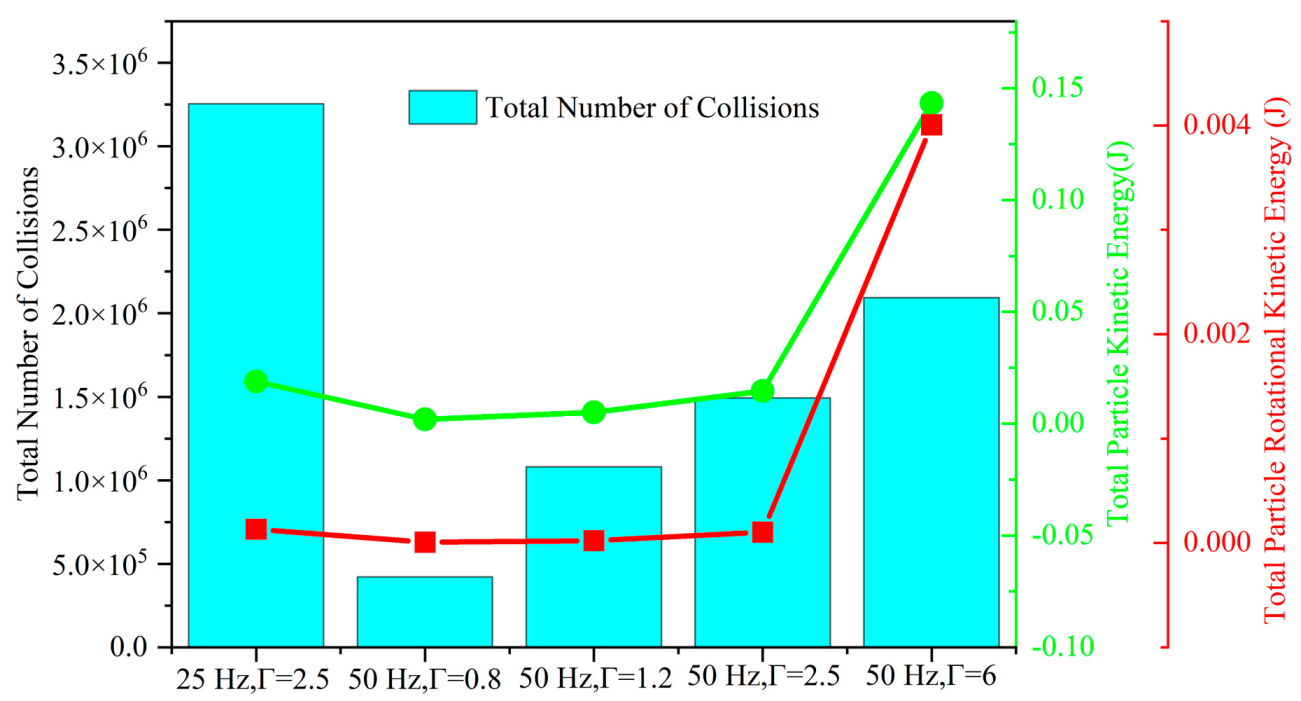
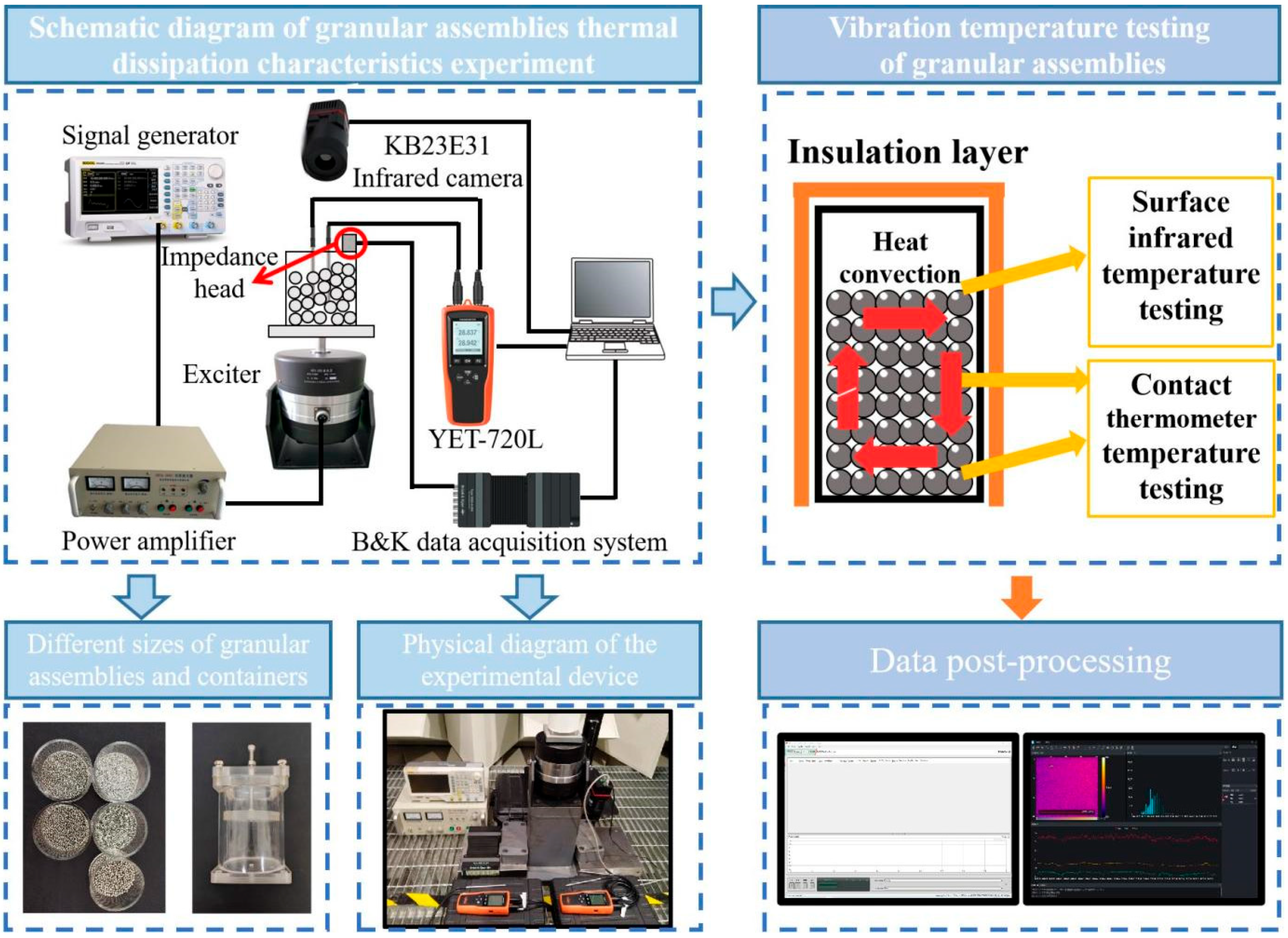
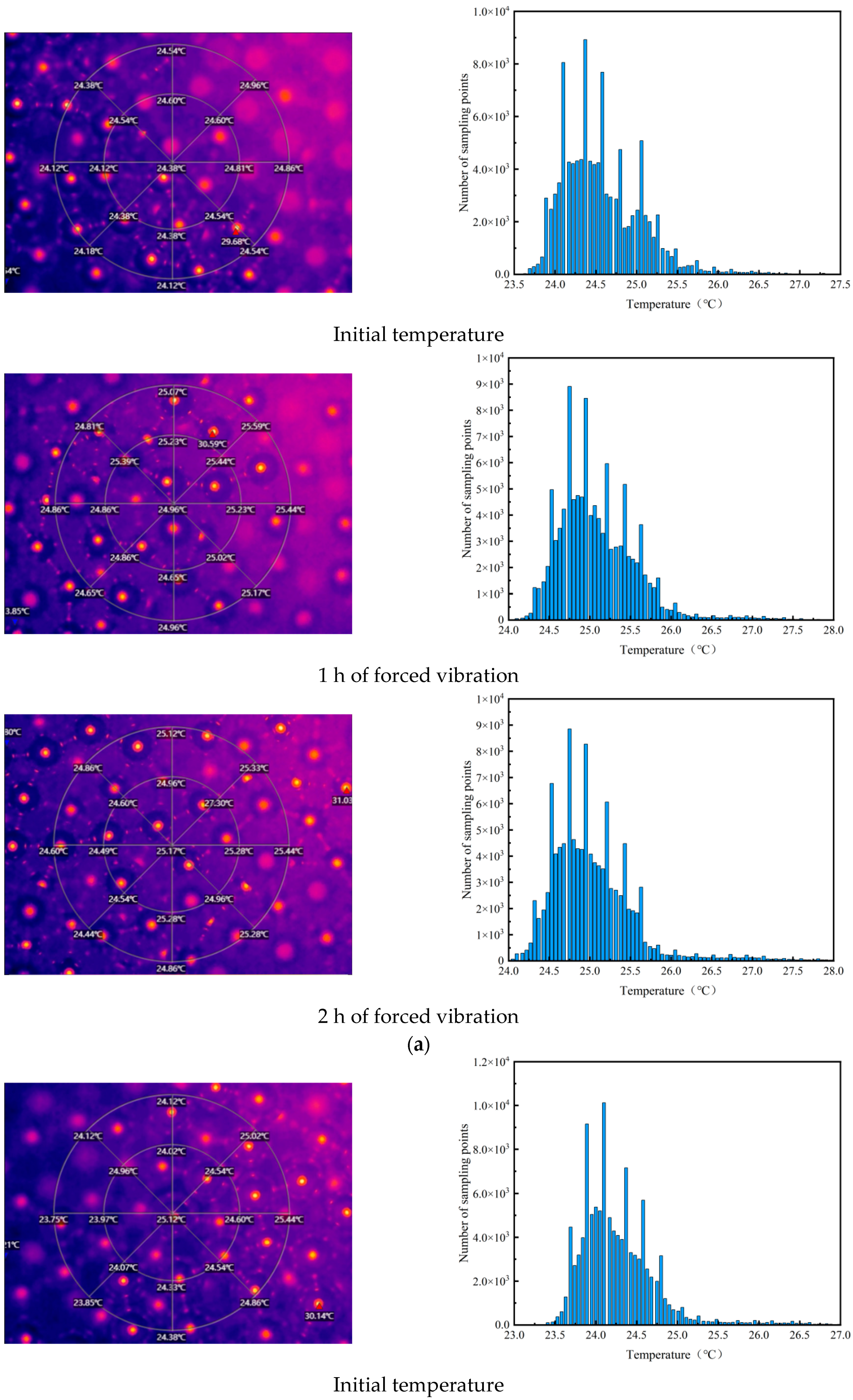
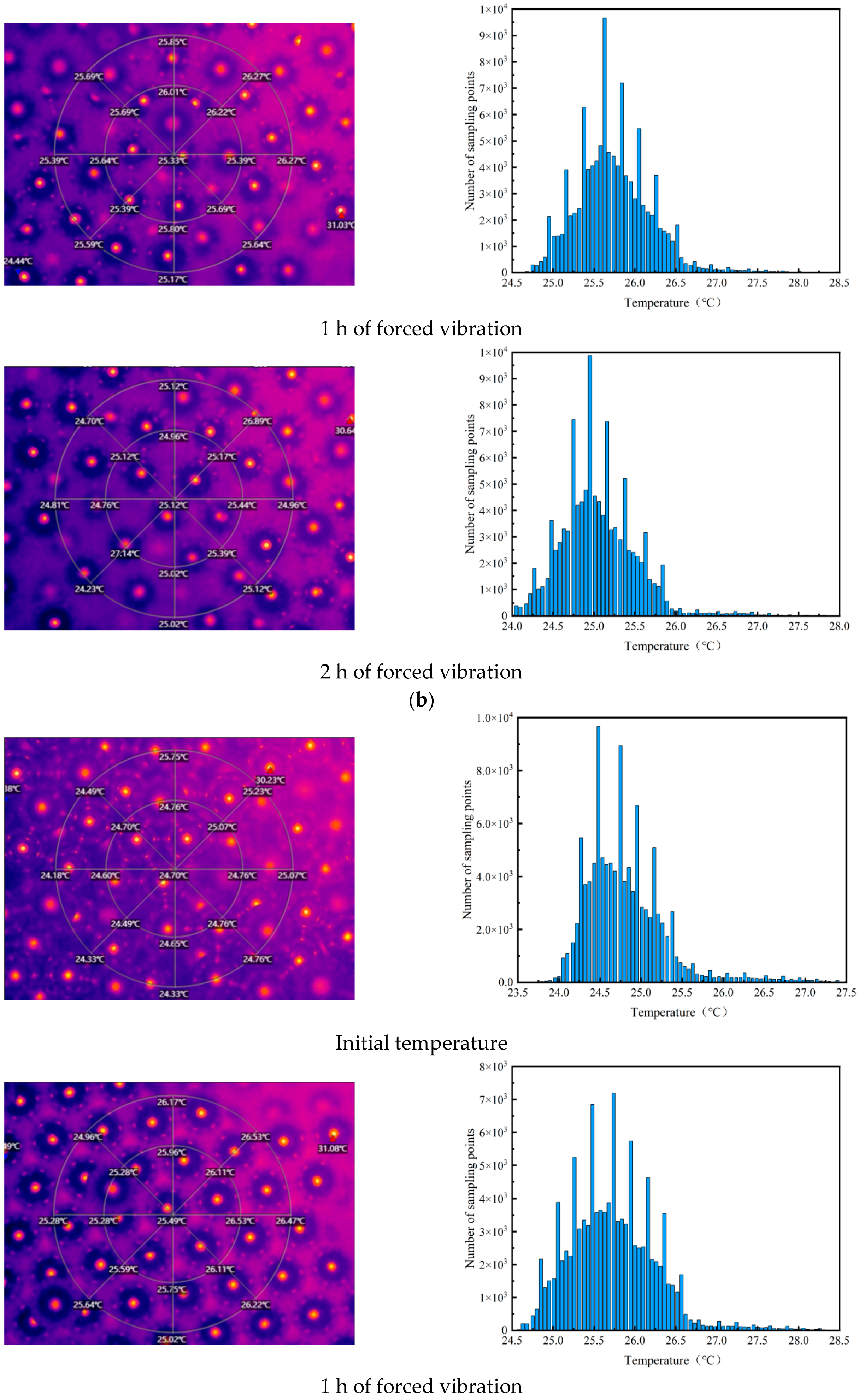

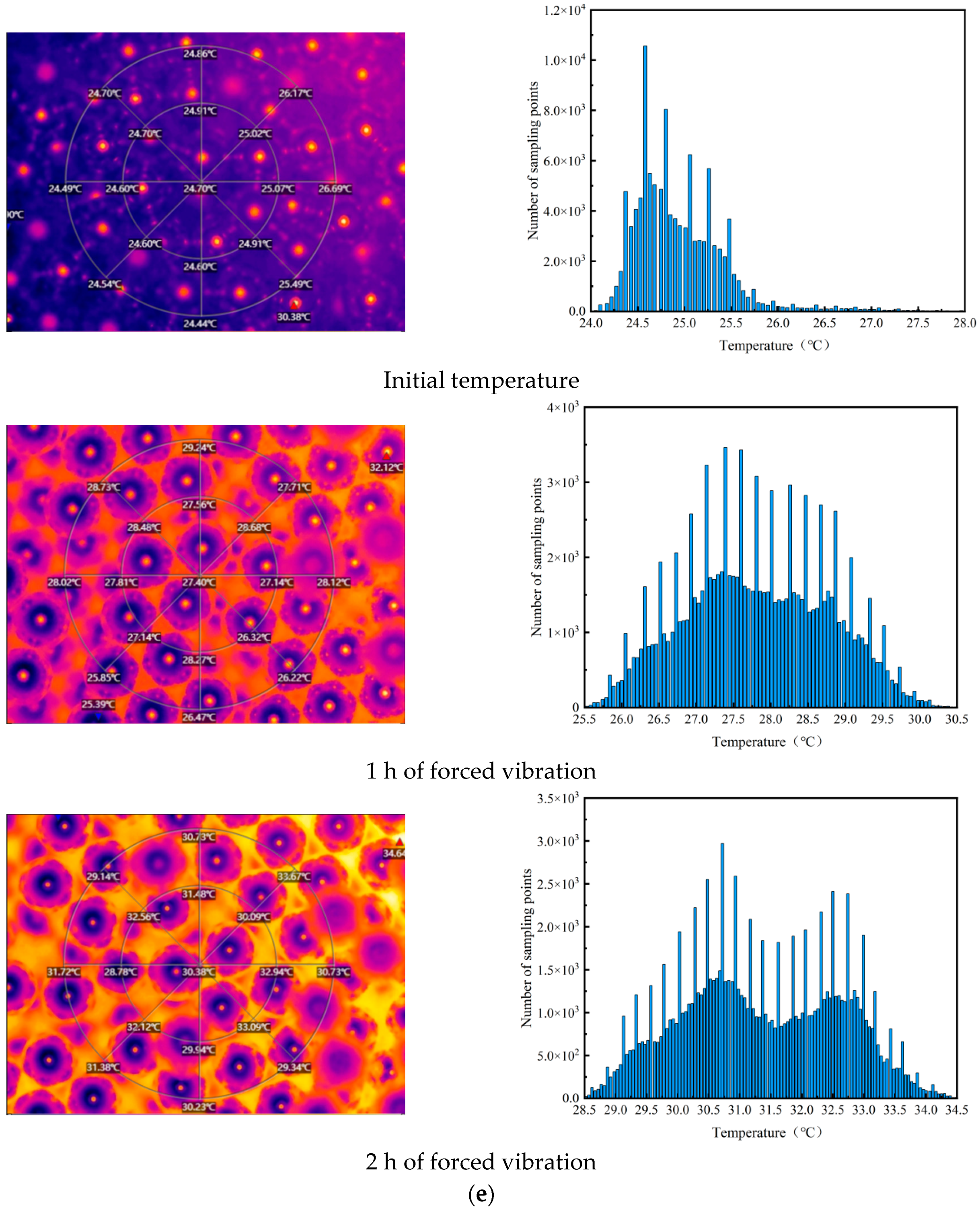
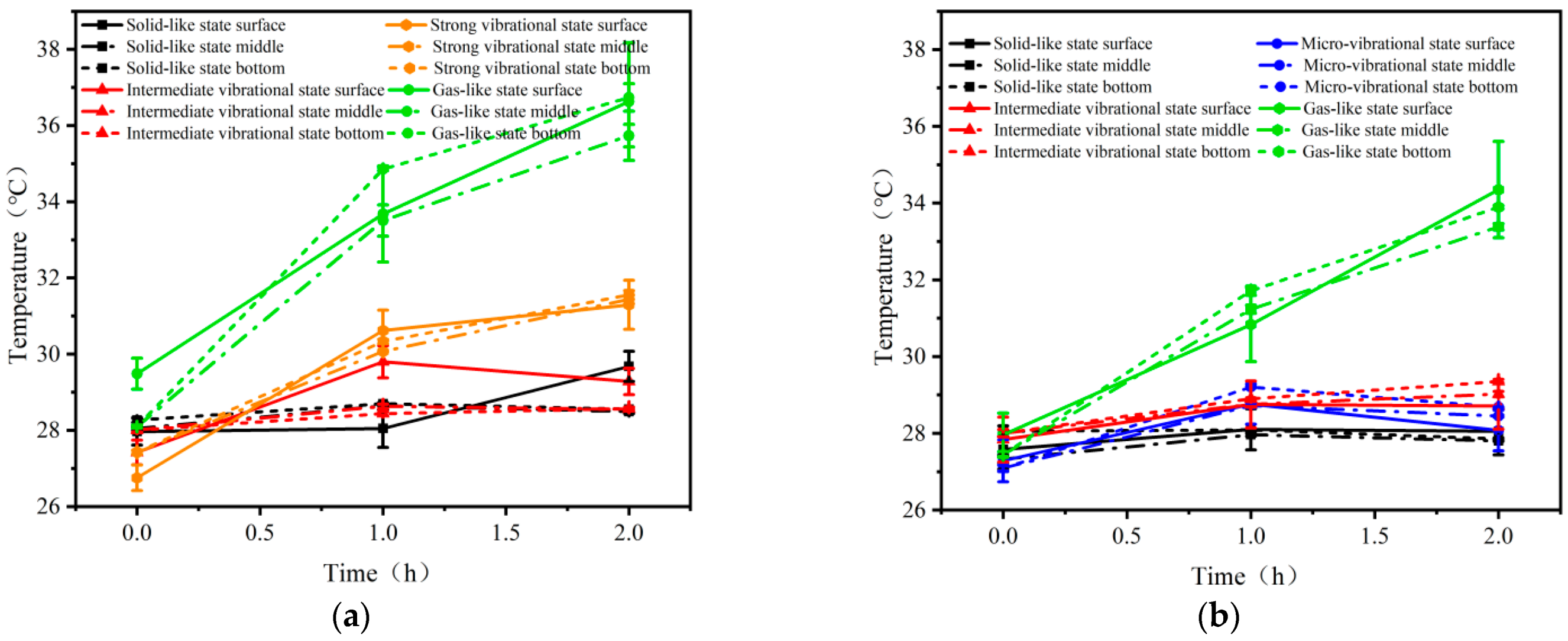

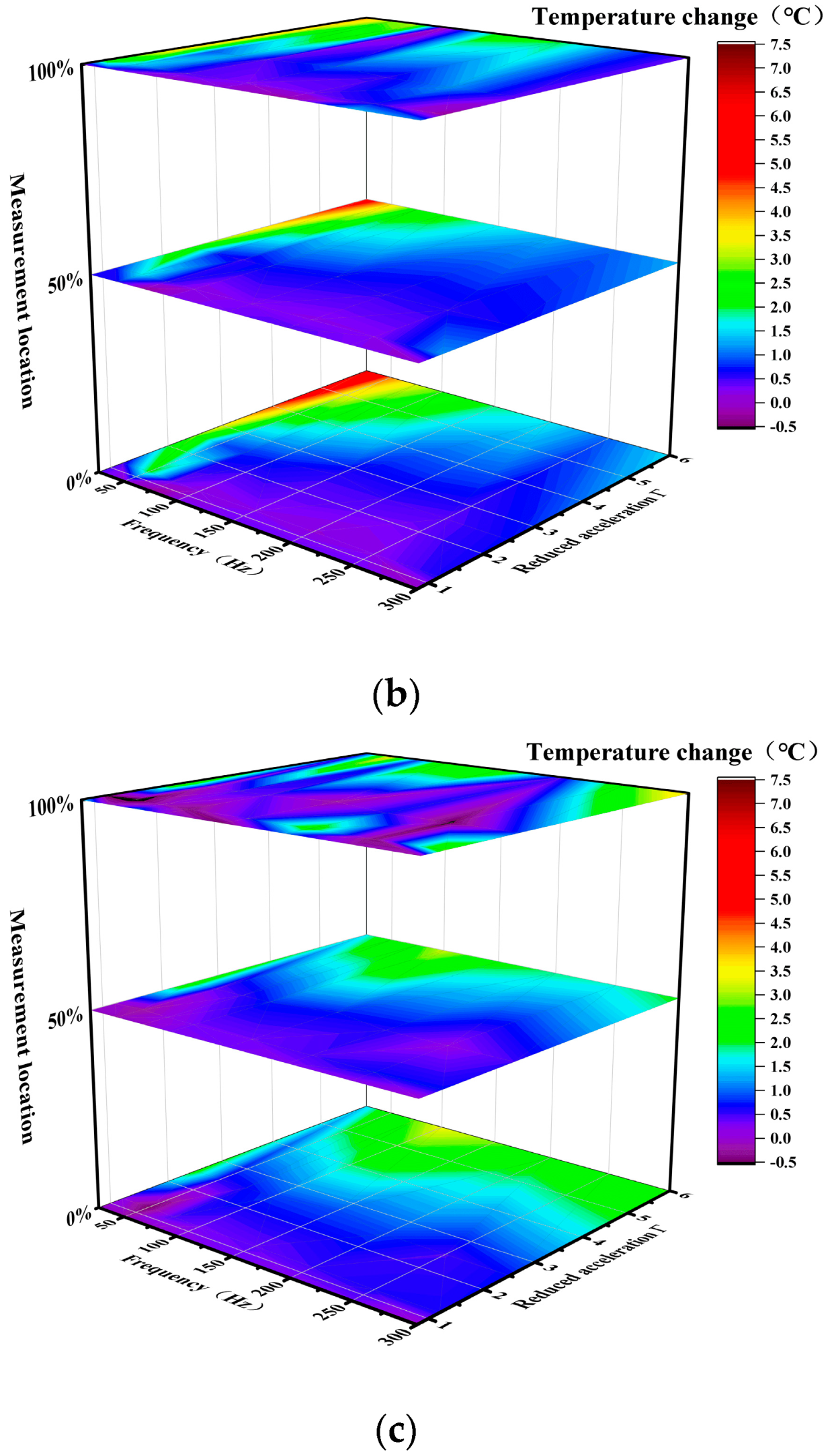

Disclaimer/Publisher’s Note: The statements, opinions and data contained in all publications are solely those of the individual author(s) and contributor(s) and not of MDPI and/or the editor(s). MDPI and/or the editor(s) disclaim responsibility for any injury to people or property resulting from any ideas, methods, instructions or products referred to in the content. |
© 2024 by the authors. Licensee MDPI, Basel, Switzerland. This article is an open access article distributed under the terms and conditions of the Creative Commons Attribution (CC BY) license (https://creativecommons.org/licenses/by/4.0/).
Share and Cite
Zhang, S.; Xu, W.; Wang, C.; Zhang, Y.; Li, Y.; Cheng, J. Research on Thermal Dissipation Characteristics Based on the Physical Laws of Forced Vibration in Granular Assemblies. Appl. Sci. 2024, 14, 5864. https://doi.org/10.3390/app14135864
Zhang S, Xu W, Wang C, Zhang Y, Li Y, Cheng J. Research on Thermal Dissipation Characteristics Based on the Physical Laws of Forced Vibration in Granular Assemblies. Applied Sciences. 2024; 14(13):5864. https://doi.org/10.3390/app14135864
Chicago/Turabian StyleZhang, Shengwu, Wei Xu, Chiming Wang, Yuanchao Zhang, Yanan Li, and Jianwei Cheng. 2024. "Research on Thermal Dissipation Characteristics Based on the Physical Laws of Forced Vibration in Granular Assemblies" Applied Sciences 14, no. 13: 5864. https://doi.org/10.3390/app14135864
APA StyleZhang, S., Xu, W., Wang, C., Zhang, Y., Li, Y., & Cheng, J. (2024). Research on Thermal Dissipation Characteristics Based on the Physical Laws of Forced Vibration in Granular Assemblies. Applied Sciences, 14(13), 5864. https://doi.org/10.3390/app14135864





